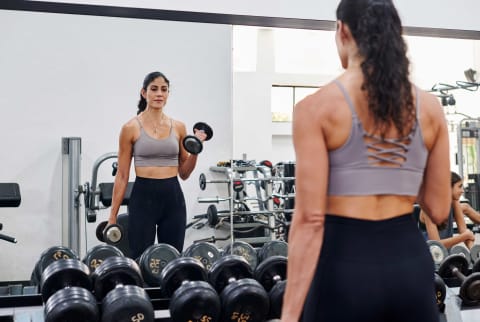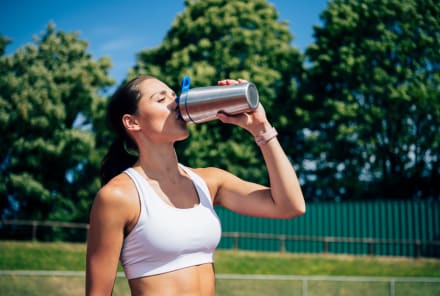Advertisement
How Women Can Prevent Injury While Weightlifting In Their 40s & Beyond


Women are being told to lift heavy weights for the sake of their health—and I totally agree with the sentiment.
But while I believe resistance training is the key to aging well (and developing confidence and mental resilience), one aspect of it is being grossly overlooked: Most women, especially those who are now in perimenopause, grew up in the era of step class and cardio kickboxing. It wasn't popular for women to be in the weight room until recently, and many of us were not taught how to lift properly.
After 16 years in private practice caring for thousands of female patients, these are my top tips for women looking to build muscle safely and without injury.
Why women are more injury-prone—especially once they hit perimenopause
There are well-documented increases in tendon and ligament injury risk among premenopausal and postmenopausal women. For example, women are at greater risk than men of sustaining an anterior cruciate ligament (ACL) rupture1 in the years leading up to menopause. One of the working hypotheses for elevated ACL injury in females is that long-term exposure to high levels of circulating estrogen influences tendon and ligament collagen turnover, composition, and function, and thereby, susceptibility to injury.
Another area we see commonly injured is the shoulder—most often presenting as adhesive capsulitis (also known as frozen shoulder). While frozen shoulder can affect both sexes, it is most commonly diagnosed in women aged 40-602. Although we don't know exactly why frozen shoulder occurs, changes in sex hormones, loss of collagen, and an overexpression of fibroblasts that drive an immune response within the shoulder joint could be risk factors for women.
To make matters worse, when ligaments and tendons are injured during perimenopause or menopause, they can take more time to heal due to hormonal changes that occur during this time—namely, the attenuation of estrogen.
How to prevent injuries in the gym
Consider this a road map for how perimenopausal and menopausal women can build muscle, prevent injury, and maximize their time in the gym:
Do a muscle-specific warmup
The first thing you want to think about when gearing up to lift any weights is how you can best direct neural attention to the muscles in question. Anatomically, nerves and blood vessels travel beside each other through the body, so where (neural) attention goes, energy (blood) flows.
Warm-ups have classically been thought of as five or 10 minutes on the treadmill. While not a bad idea, this isn't a great one if you are going to be lifting weights. A good warm-up is specific to the movement patterns in question. So ask yourself: What are going to be the best movement patterns to prime my muscles for the work they're about to do?
Let's say it's leg day and you're going to be squatting with weights. Irrespective of the kind of squat or the machine you might be using, you want to prime the body for the squatting motion. What better way to prepare your body for squats than…well…with squats? Body-weight squats, Smith machine squats (with no weight), or back squats with a barbell with no plates on it are excellent choices for a warm-up if weighted squats are on the menu.
If you are scheduled for some pull-ups, why not start with assisted pull-ups on a machine? If you are going to be deadlifting, why not deadlift just the bar?
The other objective of a muscle-specific warm-up set is to get you sweaty and ready to work. So typically I like to perform three or four sets of a warm-up before the weights get serious, progressively adding on a bit of weight each time. Remember, you're not trying to go to failure but instead ramping up the neural stimulus for when you are ready to lift heavy.
Each progressive warm-up set should get slightly more difficult. When your warm-up is complete, you should feel warm, slightly dewy (aka, you're sweaty), and ready to work.
Here is a sample warm-up set for leg day:
- Walking Lunges, body weight only: 20 reps per leg
- Walking Lunges, 10 lbs: 15 reps per leg
- Walking Lunges, 25 lbs: 12 reps per leg
Here is a sample warm-up set for back day:
- Assisted Pull-Up Machine, 130 lbs: 20 reps
- Assisted Pull-Ups, 70 lbs: 15 reps
- Assisted Pull-Ups, 45 lbs: 10 reps
(Note: the assisted pull-up machine is "easier" the heavier the weight, so as the weight gets lighter, the harder it gets.)
Summary
Play around with tempo to increase time under tension
Yes, you can grow muscle without lifting heavy weights. Manipulating the tempo of your exercises can replicate the effects of heavier weights (while reducing injury risk). Specifically, I recommend elongating the eccentric phase of the movement to be about four seconds long.
One of the biggest mistakes I see in the gym is that we tend to focus more on the concentric phase. Let's use bicep curls as an example: The concentric phase is the first part of the movement, when the muscles are shortening. The eccentric part of the movement is when you lengthen the muscle back to the starting position.
Now, be honest: How many people have you seen only focus on the first part of the curl, only to drop the weight back down and completely ignore the eccentric phase? Now be even more honest: Am I describing your form?
The eccentric phase is often the harder one, so once you slow it down, you may need to use lighter weights. For those of you who like to load plate after plate on a bar or derive a lot of satisfaction from lifting heavy, you have been warned: Slowing down the tempo and focusing on the eccentric is going to humble you in a big way.
Summary
Work the weakest point of the movement
This brings me to my last point: One of the best ways to prevent injury is by training "the weakest point" of the movement. This is another way to say that you should focus on hitting a full range of motion to drive muscle growth. Often, it's in the last few degrees of motion that we leave a lot of our goals on the table. Achieving a full range of motion is also important for injury prevention.
If you are squatting to 90 degrees of knee flexion, it's OK but not as good at tensioning out the glute as squatting below 90 degrees.
If full range is an issue (maybe you have a foot or ankle mobility issue or an arthritic condition), then keep the weights light and work on restoring your full range of motion. Go see your chiropractor or physio, and for the love of Cleopatra, do the mobility exercises they give you!
Summary
The takeaway
Once you do a targeted warmup, tempo your workout to focus on the eccentric movements, and get into the longest position possible—all while using lighter weights—I am confident you will make extraordinary progress in your muscle pursuit. By applying some of these principles to your training regimen, you are going to develop a full range of motion, beautiful muscles, and strong tendons and ligaments that resist injury and stand the test of time.
Watch Next
Enjoy some of our favorite clips from classes
Enjoy some of our favorite clips from classes
What Is Meditation?
Mindfulness/Spirituality | Light Watkins
Box Breathing
Mindfulness/Spirituality | Gwen Dittmar
What Breathwork Can Address
Mindfulness/Spirituality | Gwen Dittmar
The 8 Limbs of Yoga - What is Asana?
Yoga | Caley Alyssa
Two Standing Postures to Open Up Tight Hips
Yoga | Caley Alyssa
How Plants Can Optimize Athletic Performance
Nutrition | Rich Roll
What to Eat Before a Workout
Nutrition | Rich Roll
How Ayurveda Helps Us Navigate Modern Life
Nutrition | Sahara Rose
Messages About Love & Relationships
Love & Relationships | Esther Perel
Love Languages
Love & Relationships | Esther Perel
What Is Meditation?
Box Breathing
What Breathwork Can Address
The 8 Limbs of Yoga - What is Asana?
Two Standing Postures to Open Up Tight Hips
How Plants Can Optimize Athletic Performance
What to Eat Before a Workout
How Ayurveda Helps Us Navigate Modern Life
Messages About Love & Relationships
Love Languages
Advertisement

This Type Of Fat Is Vital For Women's Health — Are You Getting Enough?
Molly Knudsen, M.S., RDN

New Study Confirms The 3 Habits That Age Your Brain Faster
Molly Knudsen, M.S., RDN

This Type Of Fat Is Vital For Women's Health — Are You Getting Enough?
Molly Knudsen, M.S., RDN

New Study Confirms The 3 Habits That Age Your Brain Faster
Molly Knudsen, M.S., RDN













